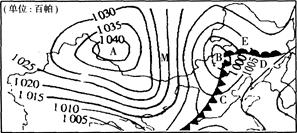该图是我国局部地区某月地面天气形势图,读图回答下列问题。(8分)

(1)此图最有可能是_______月(1或7)的地面天气形势图。就气流状况而言,A地受___________控制,B地区气流运动以__________为主(上升或下沉)。
(2)近日,将有__________锋从E地过境。C地在锋面过境时,天气将会出现的变化是_______ __________,C地在锋面过境后,天气将会出现的变化是_______ __________
(3)暖空气在锋面上常有大规模的上升运动。在C、D两地的暖空气被迫抬升的是_____________地。
(4)此时,M地的风向为_________风。
小题1:1月(1′) ; 反气旋(1′); 上升(1′)
小题2:暖锋(1′)
阴天、刮风、下雨(雪)、降温(1′)
气压升高、气温降低、湿度降低、天气转晴(1′)
小题3:C (1′)
小题4:偏北风(西北风)(1′)
题目分析:
小题1:图示亚欧大陆上被高压控制,故判断为北半球冬季。图示A处中心气压较四周高,故判断为高压中心,从气流状况看为反气旋。B地中心气压较四周低,判断为低压(气旋),垂直方向上盛行上升气流。
小题2:图示E附近有暖锋即将向E处移来。而C处为冷锋即将过境,将出现阴天、刮风、降雨、降温天气。冷锋过境后,则受冷气团控制,气温下降,气压升高,天气转晴。
小题3:暖锋为暖气团主动进攻,而冷锋为冷气团主动进攻,则暖气团被迫抬升。
小题4:直接根据图示的气压高低分布,水平气压梯度力垂直于等压线,由高压指向低压;地转偏向力北半球向右偏,风向斜穿等压线,画出M地的风向即可。
点评:本题难度不大,属于基础性试题,学生应在平时的学习中加强对基础知识点的落实,解题的关键是能从图示的等压线分布判断锋面性质和天气变化特征、风向等内容。
